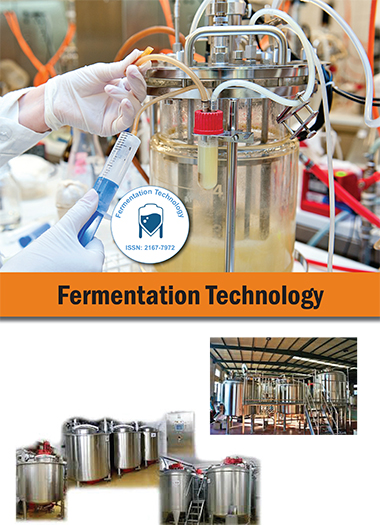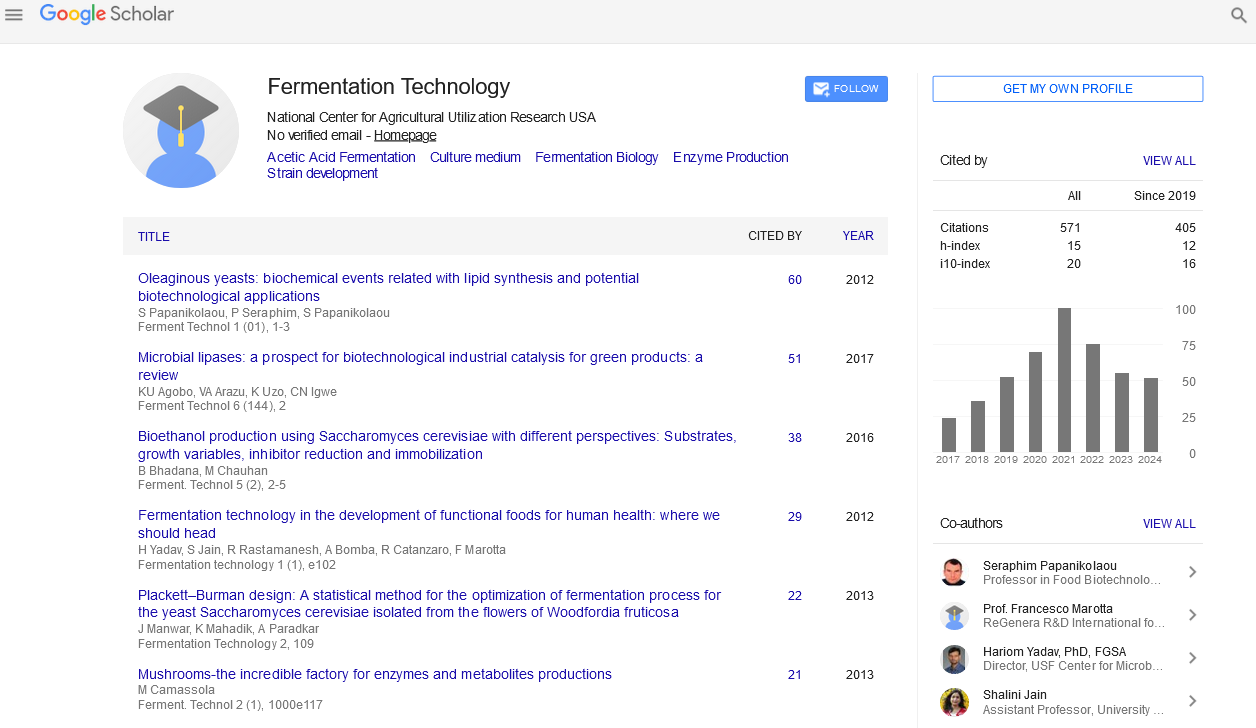Indexed In
- Open J Gate
- Genamics JournalSeek
- Access to Global Online Research in Agriculture (AGORA)
- RefSeek
- Hamdard University
- EBSCO A-Z
- OCLC- WorldCat
- Publons
Useful Links
Share This Page
Journal Flyer

Open Access Journals
- Agri and Aquaculture
- Biochemistry
- Bioinformatics & Systems Biology
- Business & Management
- Chemistry
- Clinical Sciences
- Engineering
- Food & Nutrition
- General Science
- Genetics & Molecular Biology
- Immunology & Microbiology
- Medical Sciences
- Neuroscience & Psychology
- Nursing & Health Care
- Pharmaceutical Sciences
Commentary - (2025) Volume 14, Issue 1
Exploring Novel Yeast Strains for Enhanced Ethanol Production from Lignocellulosic Biomass
John Wilson*Received: 26-Feb-2025, Manuscript No. FMT-25-29069; Editor assigned: 28-Feb-2025, Pre QC No. FMT-25-29069 (PQ); Reviewed: 13-Mar-2025, QC No. FMT-25-29069; Revised: 20-Mar-2025, Manuscript No. FMT-25-29069 (R); Published: 27-Mar-2025, DOI: 10.35248/2167-7972.25.14.179
Description
With increasing concerns over fossil fuel depletion and environmental degradation, bioethanol has gained significant attention as a renewable alternative. Among various feedstocks, lignocellulosic biomass comprising agricultural residues, forest waste and energy crops offers a plentiful and low-cost resource. However, its complex structure and inhibitory by-products make bioethanol production challenging. The discovery and application of novel yeast strains hold significant potential to overcome these bottlenecks, offering better tolerance, substrate utilization and yield.
Understanding lignocellulosic biomass
Lignocellulosic materials consist of cellulose, hemicellulose and lignin. While cellulose and hemicellulose provide fermentable sugars (glucose, xylose, arabinose), lignin forms a rigid matrix that resists microbial degradation. Pre-treatment methods such as steam explosion, acid hydrolysis, or enzymatic digestion are necessary to release sugars. Unfortunately, these steps often generate inhibitors like furfural, Hydroxymethylfurfural (HMF) and organic acids that suppress yeast performance.
Limitations of conventional yeast strains
Saccharomyces cerevisiae is the most widely used microorganism in ethanol production due to its high fermentative capacity and tolerance to ethanol. However, it naturally lacks the ability to ferment pentoses such as xylose and arabinose, which make up a substantial portion of hemicellulose-derived sugars. Additionally, its sensitivity to inhibitors from lignocellulose hydrolysates limits overall efficiency. This necessitates either genetic modification or exploration of alternative yeast strains.
Screening and isolation of novel yeast strains
Natural environments such as forest soil, decaying wood and compost heaps are rich in microbial diversity. These habitats have been the source of several yeast species with enhanced fermentative traits. Strains like Scheffersomyces stipitis, Pichia kudriavzevii, Candida shehatae and Kluyveromyces marxianus have shown the ability to ferment both hexoses and pentoses. Advanced screening methods involving selective media, fermentation profiling and genomic sequencing enable efficient identification of suitable candidates.
Genetic engineering and hybrid strains
To combine the strengths of different yeasts, researchers have developed recombinant strains through genetic engineering. For instance, genes responsible for xylose transport and metabolism from S. stipitis have been introduced into S. cerevisiae to enable pentose utilization. Similarly, adaptive evolution under selective pressure improves tolerance to inhibitors and ethanol. Hybrid strains created through protoplast fusion or genome shuffling have also shown promise in fermenting mixed sugars more efficiently than parent strains.
Inhibitor tolerance mechanisms
One of the desirable traits in novel yeast strains is the ability to tolerate compounds like furfural, HMF and acetic acid. Yeasts possess various detoxification pathways, including reduction of furfural to less toxic alcohols or active efflux pumps to remove inhibitors.
Selecting or engineering strains with such traits improves fermentation efficiency in real lignocellulosic hydrolysates without requiring detoxification steps, which are costly and time- consuming.
Process optimization
The fermentation environment plays a key role in determining yeast performance. Parameters such as pH, temperature, oxygen levels and nutrient supplementation are optimized for each strain. Some novel yeasts perform better under thermotolerant or microaerobic conditions, reducing cooling and aeration costs in industrial setups.
Simultaneous Saccharification and Fermentation (SSF) and cofermentation of mixed sugars are being employed to improve overall process yield and efficiency.
Industrial applications and commercialization
Several pilot- and commercial-scale bioethanol plants have begun adopting novel or engineered yeast strains. Companies are focusing on strains that can perform well in high-solids hydrolysates and produce ethanol concentrations that reduce downstream purification costs.
Additionally, the use of engineered yeasts is being extended to produce not only ethanol but also other value-added co-products such as xylitol, organic acids and lipids, which improves economic feasibility.
Environmental and economic benefits
Utilizing lignocellulosic biomass for ethanol production reduces agricultural waste and lowers greenhouse gas emissions compared to conventional fossil fuels. The adoption of novel yeasts capable of processing a wide range of sugars allows for more complete conversion of biomass, improving overall efficiency.
Economically, these advances reduce the reliance on food crops like corn and sugarcane, supporting a more sustainable biofuel economy.
Conclusion
Novel yeast strains represent an important advancement in overcoming the limitations of traditional ethanol production methods. Their ability to ferment a broader range of sugars, tolerate inhibitors and perform under varied conditions makes them strong candidates for lignocellulosic bioethanol production. Continued research in strain development, process integration and industrial scaling will further enhance the viability of second-generation biofuels in the global energy mix.
Citation: Wilson J (2025). Exploring Novel Yeast Strains for Enhanced Ethanol Production from Lignocellulosic Biomass. Ferment Technol. 14:179.
Copyright: © 2025 Wilson J. This is an open-access article distributed under the terms of the Creative Commons Attribution License, which permits unrestricted use, distribution and reproduction in any medium, provided the original author and source are credited.

